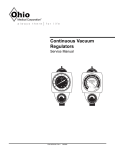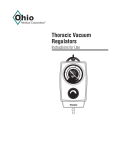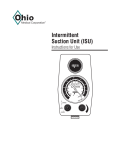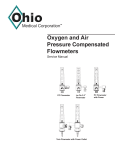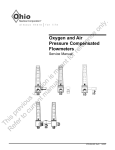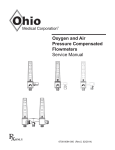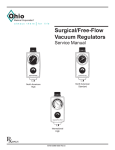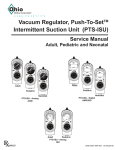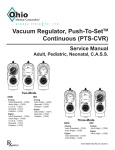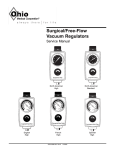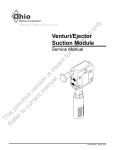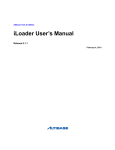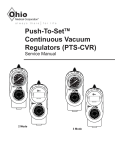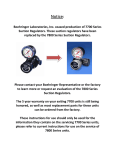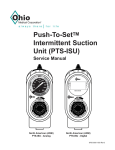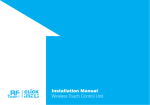Download 6700-0072-000 CVR service manual RevD.qxp
Transcript
Continuous Vacuum Regulators Service Manual MED 400 300 60 100 120 -mmHg 500 60 140 40 160 HIGH LOW 80 70 600 20 180 200 F U L L V AC 6700-0072-000 RevD 10/2007 80 50 40 High Flow High Vacuum 20 90 700 200 30 10 100 - kP a Hg -mm 100 User Responsibility This Product will perform in conformity with the description thereof contained in this manual and accompanying labels and/or inserts, when assembled, operated, maintained and repaired in accordance with the instructions provided. This Product must be checked periodically. A malfunctioning Product should not be used. Parts that are broken, missing, plainly worn, destroyed or contaminated, should be replaced immediately. Should such repair or replacement become necessary, Ohio Medical recommends that a telephonic or written request for service advice be made to the nearest Ohio Medical Service Office. This Product or any of its parts should not be repaired other than in accordance with written instructions provided by Ohio Medical, or altered without the prior written approval of Ohio Medical’s Safety Department. The user of this Product shall have the sole responsibility for any malfunction which results from improper use, faulty maintenance, improper repair, damage, or alterations by anyone other than Ohio Medical Corporation. Important: Federal law in the U.S.A. and Canada restricts this device to sale by or on the order of a licensed medical practitioner. This device is to be used only by persons who have been adequately instructed in its use. Important: This document is not to be reproduced in any manner, nor are the contents herein to be disclosed to anyone without the express authorization of Ohio Medical Corporation. User Responsibility The procedures described in this service manual should be performed by competent individuals who have a general knowledge of and experience with devices of this nature. No repairs should ever be undertaken or attempted by anyone not having such qualifications. Genuine replacement parts manufactured or sold by Ohio Medical must be used for all repairs. Read completely through each step in every procedure before starting the procedure; any exceptions may result in a failure to properly and safely complete the attempted procedure. User Responsibility CCW MAX in Hg kPa LPM mm Hg °C °F N-m ft-lb oz DISS OES NCG NPT NPTF MPTS gal PTFE Counterclockwise (Anti-clockwise) Full Line Vacuum Inches of mercury Kilo pascals (kPa x 7.50 = mm Hg) Liters per minute Millimeters of mercury (mm Hg x .133 = kPa) Degrees Celsius Degrees Fahrenheit Newton-Meter (N-m x .737 = ft-lb) Foot-Pound Force (ft-lb x 1.356 = N-m) Ounces Diameter Index Safety System Oxequip Suction National Compressed Gases (Chemetron) National Pipe Thread (USA) National Pipe Thread Female (USA) Multi-Purpose Therapy Stand Gallon Teflon® 6700-0072-000 RevD 10/2007 Table of Contents 1/Precautions 1.1 Definitions . . . . . . . . . . . . . . . . . . . . . . . . . . .1-1 1.2 Warnings . . . . . . . . . . . . . . . . . . . . . . . . . . . .1-1 1.3 Cautions . . . . . . . . . . . . . . . . . . . . . . . . . . . . .1-2 3/Description and Specifications 3.1 Description . . . . . . . . . . . . . . . . . . . . . . . . . . .3-1 3.2 Specifications . . . . . . . . . . . . . . . . . . . . . . . . .3-2 8/Service Checkout Procedure 8.1 Set-up . . . . . . . . . . . . . . . . . . . . . . . . . . . . . .8-1 8.2 Flow Test . . . . . . . . . . . . . . . . . . . . . . . . . . . .8-1 8.3 Gauge Test . . . . . . . . . . . . . . . . . . . . . . . . . . .8-2 8.3.1 High Vacuum Gauges ONLY . . . . . . . .8-2 8.3.2 Standard and Low Vacuum Gauges ONLY . . . . . . . . . . . . . . . . . . .8-2 8.4 Regulation Test . . . . . . . . . . . . . . . . . . . . . . .8-2 8.5 Low Vacuum Regulators ONLY . . . . . . . . . . .8-2 8.6 Bleed Test . . . . . . . . . . . . . . . . . . . . . . . . . . .8-2 8.7 Leak Test - Supply Side . . . . . . . . . . . . . . . . .8-3 8.8 Leak Test - Patient Side . . . . . . . . . . . . . . . . . . .8-4 4/Operation 4.1 Equipment Set-up . . . . . . . . . . . . . . . . . . . . .4-1 4.2 Attaching the Safety Trap . . . . . . . . . . . . . . .4-2 4.3 Mode Selection . . . . . . . . . . . . . . . . . . . . . . .4-3 4.4 Setting the Suction Level . . . . . . . . . . . . . . . .4-4 4.5 Pre-Use Checkout Procedure . . . . . . . . . . . .4-4 4.6 Patient Set-up . . . . . . . . . . . . . . . . . . . . . . . .4-7 9/Maintenance 9.1 General Maintenance of Suction Equipment .9-1 9.2 Recommended Maintenance Schedule . . . . .9-1 9.2.1 Maintenance Schedule . . . . . . . . . . . . . . . . . .9-1 9.3 Repair Policy . . . . . . . . . . . . . . . . . . . . . . . . .9-2 9.4 Technical Assistance . . . . . . . . . . . . . . . . . . .9-2 9.5 Return Instructions . . . . . . . . . . . . . . . . . . . . .9-2 5/Cleaning and Sterilization 5.1 Cleaning . . . . . . . . . . . . . . . . . . . . . . . . . . . . .5-1 5.1.1 Routine Exterior Cleaning . . . . . . . . . . .5-1 5.1.2 Internal Component Cleaning . . . . . . . .5-1 5.2 Sterilization . . . . . . . . . . . . . . . . . . . . . . . . . . .5-1 10/Ordering Information 10.1 Illustrated Parts . . . . . . . . . . . . . . . . . . . . . .10-1 10.2 Service Kits . . . . . . . . . . . . . . . . . . . . . . . . .10-2 10.3 Fittings and Adapters . . . . . . . . . . . . . . . . . .10-2 10.4 North American . . . . . . . . . . . . . . . . . . . . . .10-3 10.4.1 Regulator Options . . . . . . . . . . . . . . .10-3 10.4.2 Other Options . . . . . . . . . . . . . . . . . .10-4 10.5 International . . . . . . . . . . . . . . . . . . . . . . . . .10-5 10.5.1 Regulator Options . . . . . . . . . . . . . . .10-5 10.5.2 Other Options . . . . . . . . . . . . . . . . . .10-6 2/Scope 2.1 North American Vacuum Regulators. . . . . . . .2-1 2.2 International Vacuum Regulators . . . . . . . . . .2-2 6/Troubleshooting 7/Service - Disassembly and Assembly 7.1 Service Tools and Equipment . . . . . . . . . . . .7-1 7.2 Continuous Vacuum Regulators (All Models) 7-1 7.2.1 Disassembly . . . . . . . . . . . . . . . . . . . . .7-1 7.2.2 Assembly . . . . . . . . . . . . . . . . . . . . . . . .7-3 7.3 Suction Level Limit Setting - Low Models ONLY . . . . . . . . . . . . . . . . . . . . . . . . .7-3 7.3.1 Low Vacuum Limiting Screws . . . . . . . .7-3 7.3.2 Vacuum Relief Valve Adjustment . . . . .7-4 7.4 Regulator Module . . . . . . . . . . . . . . . . . . . . . .7-4 7.4.1 Disassembly . . . . . . . . . . . . . . . . . . . . .7-4 7.4.2 Assembly . . . . . . . . . . . . . . . . . . . . . . . .7-5 Appendix Installation procedure for Adapters/Probes and Fittings. A-1 6700-0072-000 RevD 10/2007 1/Precautions 1.1 Definitions Note: A Note provides additional information to clarify a point in the text. Important: An Important statement is similar to a note but of greater emphasis. CAUTION: A CAUTION statement is used when the possibility of damage to the equipment exists. WARNING: A WARNING statement is used when the possibility of injury to the patient or the operator exists. = Attention. Alerts you to a warning or caution in the text. MAX = maximum High Flow High Vacuum = high flow, high vacuum High Flow Low Vacuum = high flow, low vacuum I (On) = on O (Off) = off = MW 0086 European Union Representative 1.2 Warnings The Pre-Use Checkout Procedure must be performed before using this equipment on each patient. If the regulator fails any part of the Pre-Use Checkout Procedure, it must be removed from service and repaired by qualified service personnel. Connect the Vacuum Regulator to the vacuum source only. Connection to pressure sources even momentarily could injure the patient or operator and damage the equipment. Always connect the regulator to the vacuum source and check its operation before attaching the patient connection. The fitting port of the regulator must be occluded when setting the prescribed suction level. This prevents the patient from receiving higher than required suction levels. Do not use this device in the presence of flammable anesthetics. Static charges may not dissipate and a possible explosion hazard exists in the presents of these agents. Handle in accordance with your hospital’s infection control policy. Clean and sterilize all suction equipment before shipment or service to ensure transportation personnel and/or service personnel are not exposed to any hazardous contamination. Clean and sterilize all suction equipment if contaminated before disassembly, to ensure service personnel are not exposed to hazardous contamination. Following sterilization with ethylene oxide, parts should be quarantined in a well ventilated area to allow dissipation of residual ethylene oxide gas absorbed by the material. Aerate parts for 8 hours at 130oF (54oC). If the Vacuum Regulator is repaired or disassembled in any manner, the Service Checkout Procedure must be performed before using the equipment on the patient. The Low Vacuum Limit Setting Procedure must be followed when repairing Low Vacuum Regulators. Failure to do this may result in suction exceeding the prescribed level. After patient use, regulators may be contaminated. 1-1 6700-0072-000 RevD 10/2007 Precautions/1 1.3 Cautions Do not lubricate any internal components of the regulator module. Do not use any Loctite® products to seal the fitting and adapter port threads (or products which contain Methacrylate Ester as an active ingredient). Only competent individuals trained in the repair of this equipment should attempt to service it. To help prevent aspirate from entering the regulator, as a result of misuse, an Overflow Safety Trap and suction filter should be attached prior to its use. Aspirate in the regulator will impair the operation. The use of the Overflow Safety Trap and suction filter will help prevent this and extend the life of the suction equipment. Use of lubricants other than recommended may degrade plastic or rubber components. Prior to placing the unit back into service after repair or dissassembly, perform the Service Check-out Procedure. Not for Field or Transport use** ®Loctite is a registered trademark of the Loctite Corp. ** The categories of Field and Transport Use are specifically defined in ISO 10079-3 (BS 7259: Part 2). "Field" means use at accidents or emergencies outside a hospital. "Transport" means use in ambulances, cards and airplanes. These situations may expose the equipment to uneven support, water, dirt mechanical shock and temperature extremes. Ohio Medical suction equipment has not been tested to comply with the specific requirements of these categories. 6700-0072-000 RevD 10/2007 1-2 2/Scope This service manual contains service, maintenance and parts information on all models of the Continuous Vacuum Regulator. North American International 2.1 North American Vacuum Regulators. Note: Part numbers given are for Vacuum Regulators without fittings or adapters. ME D MED 80 60 40 160 L OW 140 HIGH LOW 120 -mmHg 20 40 100 120 Low Vacuum H 60 100 G HI 80 140 mm Hg 160 20 180 200 F U L L V AC Standard Two Mode Continuous 6700-1225-900 0-200 mmHg-FULL VAC Standard Three Mode Continuous 6700-1224-900 0-200 mmHg-FULL VAC Low Continuous 6700-1227-900 0-135 mmHg High Three Mode Continuous 6700-1226-900 0-760 mmHg 2.2 International Vacuum Regulators Important: International Vacuum regulators comply with the requirements of EN ISO 10079-3 and are CE marked. Note: Part numbers given are for Vacuum Regulators without fittings or adapters. 100 400 300 70 600 80 50 60 High Flow High Vacuum 200 30 90 700 300 500 40 600 20 10 70 100 100 80 50 High Flow High Vacuum 700 16 12 60 10 8 18 4 100 2 100 Hg -mm -k Hg Two Mode High Continuous 6700-1230-900 CCW 0-760 mmHg/0-100 kPa 6700-0072-000 RevD 40 6 a - kP Three Mode High Continuous 6700-1229-900 CCW 0-760 mmHg/0-100 kPa 2-1 140 14 20 20 10 a - kP -mm 200 30 90 80 120 40 20 Pa 60 10/2007 High Flow Low Vacuum Hg 400 500 m -m Two Mode Low Continuous 6700-1233-900 CCW 0-135 mmHg/0-18 kPa Description and Specification/3 3.1 Description WARNING Do not use this device in the presence of flammable anesthetics. Static charges may not dissipate and a possible explosion hazard exists in the presence of these agents. The Continuous Vacuum Regulator is a lightweight, compact unit used throughout the hospital primarily for pharyngeal/tracheal suctioning (airway management). Various models provide regulated or full-line vacuum for hospital suction procedures. There are several models of the Continuous Vacuum Regulators. All models contain a vacuum gauge which indicates suction supplied by the regulator. Each has a positive pressure safety relief valve to prevent pressurization by either failed injector vacuum (venturi) units or inadvertent cross connection to pressurized gasses. In addition, the Low Continuous models include a vacuum relief valve to limit maximum suction. Some models operate in a regulated or non-regulated (MAX) mode. Others operate only in the regulated (limited) mode. as an automatic valve. Turning the suction control knob adjusts the position of the regulator module and allows selection of a predetermined level of suction when set according to instructions. During use, as the flow requirement increases, the valve automatically opens to maintain suction at the preset level. Conversely, when the flow requirement decreases, the valve automatically closes to maintain suction at the preset level. The same mechanism compensates for changes in supply vacuum and automatically maintains the pre-set suction level when set according to instructions. 1. Suction Control Knob - Allows easy adjustment of suction to the patient. 2. Mode Selector Switch - Allows quick and easy mode changes. a. | (On) - Suction can be adjusted with the suction control knob. b. O (Off) - No suction is supplied to the patient. c. MAX - Maximum full-line vacuum is supplied to the patient. 3. Vacuum Gauge - The suction level to the patient is displayed during use. In the non-regulated (MAX) mode, the vacuum source is connected directly to the fitting port. The regulator module is bypassed and full-line vacuum is provided. In the regulated (limited) mode, the vacuum source is connected through the regulator module which functions Mode Selector Switch 400 300 500 Vacuum Gauge 60 70 600 80 50 40 High Flow High Vacuum 20 90 700 200 30 10 100 100 - kP a Hg -mm Adapter Port Suction Control Knob Fitting Port Front and Side View 6700-0072-000 RevD 10/2007 3-1 3/Description and Specifications 3.2 Specifications Gauge: Accuracy: ±5% of full scale deflection Flow Rate: 0 to 80 LPM without fittings at full increase setting depending on supply vacuum and open air flow Positive Pressure Safety Relief Valve: Located in the vacuum supply line to prevent pressurization of the patient connection by failed injector vacuum (venturi) units, or inadvertent cross connection to pressurized gases Ranges: Gauge Range Regulated Suction Standard Models High Models Low Models 0 to 200 mm Hg/0 to 26 kPa 0 to 760 mm Hg/0 to 100 kPa 0 to 160 mm Hg/0 to 21 kPa 0 to 760 mm Hg/0 to 100 kPa 0 to 760 mm Hg/0 to 100 kPa 0 to 135 mm Hg/0 to 18 kPa* * When measured with an independent measuring device. Vacuum Relief Valve (Low Vacuum models ONLY): 140 mm Hg ± 5 mm Hg/18.7 kPa ± 0.7 kPa Weight: (Less fittings) 11 oz/312 grams Weight Low Vacuum models: (Less fittings) 12 oz/340 grams Dimensions: (Less fittings) Height: 5.7 inches/145 mm Width: 3.0 inches/76 mm Depth: 3.8 inches/96 mm Latex tubing, 0.25 in (6.4 mm) I.D. X 12 in (30 cm) supplied: 0 to full vacuum Flow dependent on source and setup Disposable tubing (Available separate in some markets; 6 mm I.D. X 450 mm, 750 mm and 2M) to connect regulator and collection bottle 0 to full vacuum Flow dependent on source and setup Disposable Suction Filter: 0 to full vacuum 0 to 100 Lpm @ 650 mmHg (-87 kPa) Environmental Specifications Operating Temperature Range: Storage Temperature Range: Operating and Storage Relative Humidity: 3-2 40oF (4oC) to 120oF (49oC) 0oF (-18oC) to 150oF (71oC) 5 to 95% 6700-0072-000 RevD 10/2007 Operation/4 4.1 Equipment Set-up Insert the probe into the vacuum wall outlet. If the regulator is mounted elsewhere, connect a vacuum supply hose between the regulator’s probe adapter and the wall outlet. WARNING Connect the vacuum regulator to the vacuum source only and check its operation before attaching the patient connection. Connection to pressure sources, even momentarily, could injure the patient or operator and damage the equipment. Note: For proper installation of Adapters/Probes and Fittings see Appendix. Connect the collection bottle's vacuum port to the regulator's fitting port or Overflow Safety Trap with the appropriate suction filter and vacuum tubing. ISO 10079-3 (BS 7259: Part 2, section 5.1.2) states that “the usable volume of the collection container shall not be less than 500 ml.” An Ohio Medical High Flow Suction Filter should be used between the collection container and regulator to prevent contamination of the regulator. Hospital-supplied suction tubing must be used between the catheter and the collection bottle. Recommended minimum inside diameter is 0.25 in (6 mm). Suction Filters - Hydrophilic Pkg of 20 6730-0350-800 Pkg of 200 6730-0351-800 Suction Filters - Hydrophobic Tubing x tubing nipple Pkg of 3 6730-0570-800 Pkg of 10 6730-0571-800 Pkg of 100 6730-0572-900 1/8 NPT x tubing nipple 6730-0580-800 6730-0581-800 6730-0582-800 Use hospital-supplied suction tubing between the end piece and the collection container, and between the patient port and the patient (minimum inside diameter is 6 mm [0.25 in.]). Vacuum Port Vacuum Regulator Patient Port 400 300 500 60 70 600 80 50 40 High Flow High Vacuum 20 90 700 200 30 10 100 100 - kP a -mm Hg Disposable Suction Filter Connective Tubing Overflow Safety Trap Collection Bottle Underwater Seal Line 2 cm H2O Made in USA Equipment Set-Up 6700-0072-000 RevD 10/2007 4-1 4/Operation 4.2 Attaching the Safety Trap CAUTION To help prevent aspirate from entering the regulator, wall outlet and pipeline system as a result of misuse, an Overflow Safety Trap should be attached prior to its use. Aspirate in the regulator, wall outlet and pipeline system may impair their operation. The use of the Overflow Safety Trap and suction filter will help prevent this and extend the life of suction equipment. Standard fitting 1. Raise the sleeve and insert the trap into the regulator fitting. Sleeve 2. Turn the trap clockwise about one and a half turns to engage the threads. The trap does not need to be screwed tight; an O-ring in the regulator fitting provides a vacuum seal. The trap should rotate freely to allow the desired tubing positioning. 3. Lower sleeve to lock trap in position. DISS fitting 1. Insert trap into the regulator fitting. Situate the tubing in the desired position. 2. Turn the DISS wing nut clockwise to engage threads and tighten (there is no O-ring, so the vacuum seal depends on a tight connection). 4-2 6700-0072-000 RevD Wing nut 10/2007 Operation/4 4.3 Mode Selection | (On) - Suction can be adjusted with the suction control knob. 2 - Mode Switch 3 - Mode Switch I/(On) O (Off) - No suction is supplied to the patient. 2 - Mode Switch 3 - Mode Switch O/(Off) MAX - Maximum, full-line vacuum is supplied to the patient. Note: available on three mode vacuum regulators only. 3 - Mode Switch MAX 6700-0072-000 RevD 10/2007 4-3 4/Operation 4.4 Setting the Suction Level 1. Turn the mode selector switch to I (On). 400 300 500 2. Occlude or clamp tubing 60 70 600 80 50 40 High Flow High Vacuum 200 30 20 90 10 100 100 700 3. Rotate the suction control knob until the vacuum gauge indicates the required setting. - kP a Hg -mm WARNING The regulator fitting port or patient connector must be occluded when setting the prescribed suction level so that the patient does not receive higher than required suction. Clamp 4.5 Pre-Use Checkout Procedure WARNINGS The Pre-Use Checkout Procedure must be performed before using the equipment on each patient. If the regulator fails any part of the Pre-Use Checkout Procedure, it must be removed from service and repaired by qualified service personnel. 400 300 500 60 70 600 700 40 200 30 20 10 100 - kP a Hg -mm Clamp All tests must be performed with supply vacuum of 380 mm Hg (51 kPa) minimum. 1. Turn the mode selector switch to O (Off). Rotate the suction control knob one full turn clockwise (increase). Clamp tubing to occlude the fitting port. The gauge needle should not move. 6700-0072-000 RevD 50 90 Connect the vacuum regulator to the vacuum source only and check it's operation before attaching the patient connection. Connection to pressure sources, even momentarily, could injure the patient or operator and damage the equipment. 4-4 80 High Flow High Vacuum 10/2007 100 Operation/4 2. Turn the mode selector switch to I (On). Rotate the suction control knob fully anti-clockwise (decrease). 400 300 500 60 70 Clamp tubing. The gauge needle should not move. 600 80 50 40 High Flow High Vacuum 200 30 20 90 10 100 100 700 - kP a -mm Hg Clamp 3. Clamp tubing. Regulator Setting 400 300 500 60 70 600 Standard & Low: increase the suction to 100 mm Hg (13 kPa) High: increase the suction to 300 mm Hg (40 kPa) 40 700 200 30 20 90 10 100 100 - kP a -mm Hg Clamp Slowly open and close the clamped tubing to create various flow rates through the regulator. Check that the suction level is maintained when the tubing is clamped. For Standard 2 Mode Continuous, go to step 5. 6700-0072-000 RevD 80 50 High Flow High Vacuum Release Clamp 10/2007 4-5 4/Operation 4a. High and Standard 3 Mode Continuous Turn the mode selector to MAX. Clamp tubing and check that the gauge needle indicates the maximum available suction. 400 300 500 50 60 70 600 40 80 20 90 Turn the mode selector to I (On). 700 200 30 High Flow High Vacuum 100 10 100 - kP a Hg -mm Clamp 4b. Low Continuous Clamp tubing and rotate knob fully clockwise (increase) to verify the suction level does not exceed 150 mm Hg (20 kPa). 100 80 120 140 16 14 12 60 10 8 18 6 20 Pa 2 -k High Flow Low Vacuum Clamp 4-6 6700-0072-000 RevD 40 4 10/2007 m -m 20 Operation/4 5. Reduce the suction level to zero and set the mode selector switch to O (Off). 400 300 500 60 70 600 80 50 40 High Flow High Vacuum 700 200 30 20 90 10 100 100 - kP a -mm Hg 4.6 Patient Setup 1. Make sure the Pre-Use Checkout Procedure has been performed. 2. Turn the mode selector switch to I (On) and clamp tubing. 400 300 500 60 70 600 80 50 40 High Flow High Vacuum 700 3. Set the prescribed suction level. 200 30 90 20 10 100 100 a - kP -mm Hg WARNING The regulator must be occluded when setting the prescribed suction level so that the patient does not receive higher than required suction. Clamp Underwater Seal Line 2 cm H2O Made in USA 6700-0072-000 RevD 10/2007 4-7 4/Operation Patient Connective Tubing 4. Turn the mode selector switch to O (Off). 5. Attach tubing to the vacuum port of the collection container. 400 300 500 50 60 70 600 40 80 200 30 High Flow High Vacuum 20 90 100 10 100 700 - kP a Hg -mm Underwater Seal Line 2 cm H2O Made in USA 6. Turn the mode selector switch to I (On). Important: The Low models do not deliver suction in excess of 150 mm Hg (20 kPa). 400 300 500 60 70 600 80 50 40 High Flow High Vacuum 700 200 30 20 90 10 100 100 a - kP -mm Hg Underwater Seal Line 2 cm H2O Made in USA 4-8 6700-0072-000 RevD 10/2007 Cleaning and Sterilization/5 5.1 Cleaning WARNING absorbed by the material. Aerate parts for 8 hours at 130oF (54oC). After patient use, regulators may be contaminated. Handle in accordance with your hospital’s infection control policy. CAUTION Do not steam autoclave or liquid sterilize the Continuous Vacuum Regulator. Severe impairment to the operation of the regulator will result. The only acceptable method of sterilization is with gas (ethylene oxide). CAUTION Sterilization with ethylene oxide mixtures may cause crazing (minute superficial cracking) of some plastic parts. Crazing will be more pronounced when mixtures containing Freon® are used. 5.1.1 Routine Exterior Cleaning Routine cleaning of the regulator is recommended as a standard procedure after each use. Wipe all exterior surfaces with a solution of water and mild detergent. 5.1.2 Internal Component Cleaning CAUTION Cleaning the gauge may result in damage. Note: The Vacuum Regulator should only be sterilized if it is contaminated or maintenance is to be performed. The regulator requires cleaning if it becomes flooded with patient fluid as a result of misuse. 1. The regulator should be sterilized with the mode selector switch in the | (On) position. 1. Refer to the Service - Disassembly and Assembly instructions. 2. The only acceptable method of sterilization is with ethylene oxide. Ethylene oxide mixtures can be used at temperatures of 125 to 135 °F (52 - 57 °C). If this temperature cannot be obtained, room temperature sterilization with 100% ethylene oxide can also be used. Sterilization is not recommended as a standard procedure after each use. 2. All internal components, with the exception of the gauge, may be cleaned with a solution of warm water and mild detergent, preferably an enzymatic cleaner. 3. Dry all components with a lint free cloth before assembly. 5.2 Sterilization Should misuse occur, resulting in accidental flooding of the regulator, the regulator may be sterilized using Ethylene Oxide (ETO). After sterilization, follow the service checkout procedures in Section 8. WARNING 3. After each sterilization, check the condition of the internal filter. If the filter appears to have shrunk, replace it before placing the regulator back in service. 4. Adequately aerate the regulator prior to disassembly, shipment or use. Aerate parts prior to reassembly. Following sterilization with ethylene oxide, parts should be quarantined in a well ventilated area to allow dissipation of residual ethylene oxide gas ®Freon is a registered trademark of the DuPont Company. 6700-0072-000 RevD 10/2007 5-1 6/Troubleshooting Problem Possible Causes Remedy A. No gauge indication and no suction in any setting 1. No supply vacuum 1. Correct supply problems 2. Kinked tube 2. Straighten tube 3. Poor connection 3. Check all connections and seals 4. Blocked adapter port 4. Unblock port 5. Blocked backplate 5. Clean with soap and water and pipe cleaner 6. Blocked adapter 6. Replace adapter 7. Blocked wall outlet 7. Unblock outlet 1. Blocked gauge pressure sensing orifice 1. Clean or replace gauge 2. Gauge mechanism locked by debris 2. Clean or replace gauge 3. Gauge mechanism damaged 3. Replace gauge 1. Blocked fitting port 1. Clean port 2. Overflow Safety Trap shut-off 2. Reset flow and/or empty trap 3. Blocked external filter 3. Replace filter 4. Blocked fitting 4. Clean fitting 1. Mode selector switch in MAX position 1. Switch to I(On) 2. Regulator module small o-ring failure 2. Replace rubber components with regulator module replacement kit 3. Regulator module diaphragm rupture 3. Replace rubber components with regulator module replacement kit 4. Regulator module stem screw loose 4. Tighten stem screw 1. Partial blockage in wall supply 1a. Confirm wall supply open air flow meets minimum hospital requirements B. No gauge indication but suction is being delivered C. Gauge indication but no suction is being delivered D. Suction level cannot be adjusted E. Insufficient flow through regulator 1b. Unblock if necessary 2. Partial blockage in regulator 2a. Perform the Flow Test in the Service Checkout Procedure Section of this manual 2b. Clear blockage if necessary 6-1 6700-0072-000 RevD 10/2007 Troubleshooting/6 Problem Possible Causes Remedy F. 1. Damaged gauge 1. Replace gauge G. With the fitting port occluded, unable to decrease the suction level and gauge needle does not return to zero when switched to O (Off) 1. Blocked filter and/or orifice 1. Clear orifice and replace filter 2. Damaged gauge 2. Replace gauge H. No suction in any setting and whistling noise from inside the regulator 1. Positive pressure safety relief valve failure 1. Replace positive pressure safety relief valve 2. Vacuum relief valve failure (low models ONLY) 2. Replace o-ring and ensure that the steel ball is present and clean Inaccurate gauge reading Note: All gauge needles should come to rest within the zero range bracket or return to the stop pin when no suction is being supplied. 6700-0072-000 RevD 10/2007 6-2 7/Service - Disassembly and Assembly 7.1 Service Tools and Equipment CAUTION Use of lubricants other than recommended may degrade plastic or rubber components. The following items should be on hand during any service procedure. • Supply vacuum: 500 mm Hg/ ± 10 mmHg (67 kPa ± 1.3 kPa) & 50 LPM open air flow minimum • Supply Vacuum Regulator with Gauge, 760 mm Hg (101.3 kPa) Full Scale. • Low Vacuum Calibration Gauge, 225 mm Hg (30 kPa) Full Scale* (Ohio Medical P/N 6700-0353-800) • High Vacuum Calibration Gauge, 760 mm Hg (101.3 kPa) Full Scale*(Ohio Medical P/N 6700-0352-800) • 50 LPM Flowmeter (Ohio Medical P/N 6700-0355800) • Hexagonal Allen Wrench 3/32 inch • Phillips Head Screwdriver, No. 2 • Flat Head Screwdriver, 1/4 inch • Pliers • Dow® 111 Grease (Ohio Medical P/N 6700-0074200) • Loctite® 242 Removable Thread Locker (Ohio Medical P/N 0220-5016-300) • Tubing Clamp • Bubble Leak Tester • Tweezers (Filter Remover) • Wooden Tooth Pick (O-ring Remover) • Pipe Cleaner 7.2 Continuous Vacuum Regulators (All Models) 7.2.1 Disassembly WARNINGS If the Vacuum Regulator is repaired or disassembled in any manner, the Service Checkout Procedure must be performed before using the equipment on a patient. Clean and sterilize all suction equipment if contaminated before disassembly, to ensure service personnel are not exposed to hazardous contamination. When servicing a Low Vacuum Regulator, perform the Vacuum Relief Valve Adjustment and Low Vacuum Limit Setting Procedure. CAUTION (*) Accuracy: ±1% of full scale deflection ®Dow is a registered trademark of the Dow Chemical Corporation 7-1 6700-0072-000 RevD 10/2007 The gauge assembly must be handled with utmost care to retain its precision. If the lens is removed, do not rest the gauge on its face. Service - Disassembly and Assembly/7 1. 2. 3. 2 Cover Screw (4) Cover Assembly Low Vacuum Limiting Screws (2) (Not Shown) (On old versions of the Low Models Only) 1 3 12 11 1 2 1. 2. 3. 4. 5. 6. 7. 8. 9. 10. 11. 12. 13. 14. Mode Selector Switch Switch Plate 13 Screw 14 O-ring, Vacuum Relief Valve (Low Models Only) 9 Vacuum Relief Valve & O-ring (Low Models Only) Gauge Assembly (includes gauge, o-rings, and lens) Lens O-ring (2), Gauge Regulator Module Positive Pressure Safety Relief Valve Filter (Internal) Base O-ring, Stem O-ring, Regulator Module 3 1 5 4 8 7 6 1. Remove the four cover screws from the back of the regulator. 2. Carefully pull the cover assembly off the back body. 3. To remove the gauge assembly, grasp the assembly and pull straight out. The snap-fit lens can also be removed (if applicable) for replacement. 4. To remove the regulator module from the cover assembly, rotate the suction control knob counterclockwise until the regulator module is free. 5. Using tweezers, remove the filter. Replace with a new filter. Pull down plastic tab with right index finger while holding gauge 6. Grasp the positive pressure safety relief valve, and pull it from the back body. 7. Remove the mounting screw from the switch plate assembly and remove the switch plate and mode switch. Snap Fit Lens Removal 8. Low models ONLY: Grasp the vacuum relief valve and pull it from the back body. 6700-0072-000 RevD 10/2007 7-2 7/Service - Disassembly and Assembly 7.2.2 Assembly CAUTION To prevent stripping the plastic threads, place the screw in the hole and turn counterclockwise until it drops into the original thread. Tighten screw. 7.3 Suction Level Limit Setting-Low Models ONLY WARNING 1. Place the positive pressure safety relief valve in position and push onto the back body. 2. Low models ONLY: Lubricate the vacuum relief valve O-ring and install it in the valve housing. 3. Lubricate the switch gasket surface with a thin coating of Dow 111 Grease. Place the mode switch on the base with the arrow at 12 o’clock. Place the switch plate onto the switch so that the OFF/O is under the arrow. Install and tighten the mounting screw. Test the mode switch at all positions. 4. Place the internal filter into the proper cavity and push until it hits the bottom of the base. 5. Place the regulator module into the cover with the screw thread facing the knob. Align the protruding ears at 3 and 9 o’clock and rotate the suction control knob clockwise until the threads engage. 6. Install the snap-fit lens by placing one of the retaining tabs over the edge of the gauge face, and then pressing lightly until the other tab snaps onto the gauge face. Rotate the lens to confirm proper installation. 7. Install the gauge assembly by lubricating the gauge o-rings with a thin coating of Dow 111 Grease and pushing the gauge into the base mount. Ensure that the gauge is properly aligned. The design of the low continuous vacuum regulator has been changed to eliminate the low vacuum limiting set screws located inside the cover behind the suction control knob. The vacuum relief valve has also been changed to limit the vacuum to the same level as the set screws did. This new vacuum relief valve has four vent holes; the old valve had two. If a new cover is used, a new vacuum relief valve must be used. Versions with limiting screws have two means of limiting the suction level: 1. Low vacuum limiting screws in the cover; these can be set at 140 mmHg/19 kPa (± 10 mmHg/1.0 kPa). 2. Vacuum relief valve; this can be set at 165 mmHg ± 15 mmHg (22 kPa ± 2 kPa). These vacuum limit settings may be reduced to accommodate user requirements. If the vacuum limit settings are reduced, the vacuum relief valve must be set 25 mmHg ± 15 mmHg (3 kPa ± 2 kPa) higher than the vacuum limiting screws. Versions without the limiting screws use only the relief valve to limit the suction level. The relief valve can be set at 140 mmHg ± 5 mmHg (18.7 kPa ± 0.7 kPa). 8. Place the cover assembly onto the base and push together until the base and back of the cover are flush. 9. Install the 4 cover screws. 7-3 6700-0072-000 RevD This Low Vacuum Limit Setting Procedure must be followed when repairing Low Vacuum Regulators. Failure to do this may result in suction exceeding the prescribed level. 10/2007 Service - Disassembly and Assembly/7 7.3.1 Low Vacuum Limiting Screws CAUTION When adjusting the vacuum limiting screws, be sure to adjust them to an equal height. Cover and Knob Assembly CAUTION Remove the “Increase” label carefully. Press firmly in place when replacing. 1. Remove the “Increase” label and place it aside. Be careful not to damage the face or glued back of the label. 2. Adjust the two vacuum limiting screws located behind the suction control knob until they are the same height in the case. Use a 3/32” hexagonal allen wrench. Allen Wrench Increase Label 3. Connect the vacuum supply to the adapter port and occlude the fitting port. Set Screws Setting the Vacuum Limiting Screws 4. Be certain that the screws remain at an equal height by adjusting both low vacuum limiting screws the same amount and in the same direction. Adjust the screws to supply a maximum vacuum of 150 mm Hg (20 kPa) and not less than 130 mm Hg (17 kPa). 7.3.2 Vacuum Relief Valve Adjustment 1. Remove the cover. 2. Connect the supply vacuum to the adapter port. Valve Body 3. Turn the mode selector switch to I/ON. Steel Ball 4. Occlude the fitting port. 5. Slowly pull the regulator module away from the base. Note the suction level at which the relief valve opens. The relief valve should open at 165 mmHg ± 15 mmHg (22 kPa ± 2 kPa) on units with limiting setscrews and140 mmHg ± 5 mmHg (18.7 kPa ± 0.7 kPa) for units without limiting setscrews. 6. If adjustment is required, grip the vacuum relief valve firmly with pliers and rotate the screw about 1/8 turn with a screwdriver. Repeat the previous step and check the suction level at which the valve opens. Note: Clockwise rotation will increase the suction level at which the relief valve opens. Counterclockwise rotation will decrease it. WARNING Excess Loctite® may seal the steel ball to the seat. This will disable the vacuum relief valve and may allow suction to exceed the preset limit. O-Ring Screw w/Magnet Loctite 242 Vacuum Relief Valve CAUTION When Loctite is used on the vacuum relief safety valve, ensure that it only contacts the metal parts. Loctite causes many plastic parts to deteriorate. 7. Lock the adjusting screw with a drop of removable thread locker such as Loctite 242. Repeat step 5 to verify the vacuum relief valve setting. ® Loctite is a registered trademark of the Loctite Corporation. 6700-0072-000 RevD 10/2007 7-4 7/Service - Disassembly and Assembly 7.4 Regulator Module WARNING If repairing or replacing a regulator module on a Low Vacuum Regulator, you must perform the Suction Level Limit Setting-Low Models ONLY Procedure. Failure to do this may result in suction exceeding the prescribed level. CAUTION Do not lubricate any internal components of the regulator module. The cap screws can strip the regulator module housing threads if they are screwed in too tight. 7.4.1 Disassembly 1. Remove the cap screws (2) and remove the cap. 2. Remove the o-rings (2). 3. Observe the position of the diaphragm convolution to aid in assembly. 4. Withdraw the diaphragm/stem assembly from the housing. 5. Remove the spring. 6. Grasp the stem with your fingers and unscrew the stem screw. 11 7. Remove the retainer, diaphragm and piston from the stem. 10 8 7 6 5 3 4 2 1 Regulator Module Parts and Descriptions 7-5 6700-0072-000 RevD 10/2007 9 11 1. 2. 3. 4. 5. 6. 7. 8. 9. 10. 11. O-ring, Stem O-ring Housing Stem Spring Piston Diaphragm Retainer Stem Screw Cap Cap Screw Service - Disassembly and Assembly/7 7.4.2 Assembly 1. Return the diaphragm to its original position (convoluted), with the molded number facing the retainer. 2. Assemble the diaphragm onto the retainer by lining up their center holes as shown in the diagram. 3. Insert the piston into the diaphragm and ensure that the retainer mates with the recess in the piston. 4. Insert the stem through the piston. 5. Holding the retainer/diaphragm/piston/stem as an assembly with your fingers, insert the stem screw and tighten. 6. Place the spring in the housing. 7. Insert the retainer/diaphragm/piston/stem assembly through the spring and into the cavity in the housing. Fit the diaphragm bead into the groove in the housing. Retainer Stem 8. Install the cap and the two cap screws. 9. Apply a small amount of Dow® 111 Grease to the orings only. Set Screw Piston Diaphragm 10. Install o-rings onto the stem and housing. Diaphragm Assembly 6700-0072-000 RevD 10/2007 7-6 8/Service Checkout Procedure 8.2 Flow Test WARNING If the Vacuum Regulator is repaired or disassembled in any manner, the Service Checkout Procedure must be performed before using the equipment on a patient. 1. Connect the regulator's fitting port to the flowmeter with tubing. 2. Rotate the suction control knob fully clockwise (increase). Important: This entire Service Checkout Procedure must be performed in numerical order. 8.1 Set-up 3. Turn the mode selector switch to I (On) and verify that the flow rate exceeds 30 LPM. 1. Verify that there is 500 mmHg ± 10 mmHg (67 kPa ± 1.3 kPa) vacuum on the supply gauge. 4. Turn the mode selector switch to MAX (if available) and verify that the flow rate exceeds 30 LPM. 2. The supply open flow must be 50 LPM minimum. 5. Turn the mode selector switch to O (Off). 3. Connect the supply vacuum to the adapter port. 6. Disconnect the flowmeter. Supply Vacuum gauge 0-760 mmHg (0-101.3 kPa) Mode Selector Switch MED 100 60 120 mmHg 140 40 160 HIGH LOW 80 20 Supply Vacuum Reg. set to 500 mmHg + 10 mmHg (64 kPa + 1.3 kPa) 180 200 F U L L V AC Occluded Flowmeter 50 LPM High Vacuum Calibration Gauge 760 mmHg/101.3 kPa Low Vacuum Calibration Gauge 225 mmHg/30 kPa Service Checkout Tests 8-1 6700-0072-000 RevD 10/2007 Supply Vacuum 500 mmHg (67 kPa) Minimum and Open Flow of 50 LPM Minimum Service Check Out Procedure/8 8.3 Gauge Test 8.4 Regulation Test Note: All Ohio Medical gauges are supplied with an accuracy of ±5% of full scale deflection throughout their range. The table below is provided for reference. 1. Disconnect the calibration gauge and occlude the fitting port. Gauge Standard Vacuum Low Vacuum High Vacuum Range 0-200 mmHg (0-26 kPa) Tolerance ±10 mmHg (1.3 kPa) 0-160 mmHg (0-20 kPa) ±8 mmHg (1.1 kPa) 0-760 mmHg (0-100 kPa) ±38 mmHg (5 kPa) Note: All gauge needles should come to rest within the zero range bracket or return to the stop pin when no suction is being supplied. Gauges which do not comply may be out of calibration. 2. If using a High Vacuum Regulator, set its gauge to 300 mmHg (40 kPa). If using a Low or Standard Vacuum Regulator, set its gauge to 100 mmHg/14 kPa. 3. Open and close the fitting port several times. 4. With the fitting port occluded, the gauge should return to the setting listed in step 2 within a tolerance of: ±38 mmHg (5 kPa) for high vacuum gauge or When checking gauge accuracy, be sure that the calibration gauge has an accuracy of 1% of full scale deflection or better. ±10 mmHg (1.3 kPa) for the standard vacuum gauges 8.3.1 High Vacuum Gauges ONLY or 1. Connect the regulator's fitting port to the high calibration gauge with tubing. ±8mmHg (1.1 kPa) for the low vacuum gauge. 2. Turn the mode selector switch to I (On). 8.5 Low Vacuum Regulators ONLY 1. Occlude the fitting port. 3. Assure that the gauge is in agreement with the high vacuum calibration gauge within the ±38 mmHg (5 kPa) tolerance. Recommended test points are 100, 300, and 500mm Hg. 8.3.2 Standard and Low Vacuum Gauges ONLY 2. Rotate the suction control knob fully clockwise (increase). 3. Verify that the suction delivered does not exceed 150 mm Hg (20 kPa) or the maximum suction requested by the clinician. 1. Connect the regulator's fitting port to the low calibration gauge with tubing. 2. Turn the mode selector switch to I (On). Note: For setting the Suction level limit, refer to Suction Level Limit Setting-Low Models ONLY. 8.6 Bleed Test 3. Assure that the gauge is in agreement with the low vacuum calibration gauge within the ±10 mmHg (1.3 kPa) or the ±8 mmHg (1.1 kPa) tolerance for standard and low gauges respectively. Recommended test points are 40, 80, and 140 mmHg. 4. For the Standard Gauge ONLY: Rotate the suction control knob fully clockwise (increase) and verify its reading is in the FULL VAC range. 1. Occlude the fitting port and set the vacuum level to 100 mm Hg (14 kPa). 2. Turn the selector switch to O (Off) and observe the gauge needle. It must return to the zero range bracket or stop pin within 10 seconds. 6700-0072-000 RevD 10/2007 8-2 8/Service Checkout Procedure 8.7 Leak Test - Supply Side 1. Connect the supply vacuum tubing to port “A” of the Bubble Leak Tester. 2. Connect port “B” of the Bubble Leak Tester to the regulator adapter port. 3. Turn the mode selector switch to O (Off). Allow the fitting port to be open to air. 4. Wait 20 seconds. No More than 6 bubbles should appear in the next ten seconds. Important: Prior to venting port "A" of the Bubble Leak Tester to atmosphere (i.e. turning the supply regulator off), ensure the tubing from port "B" has been disconnected from the adapter port of the vacuum regulator. Vacuum Regulator Supply Vacuum Gauge 0-760 mmHg (0-101.3 kPa) Supply Regulator 500 mmHg (67 kPa) Adapter Port Supply Vacuum Fitting port Port B Port A Sealed 1/4” I.D. Clear Tubing 1.0 in. Water Bubble Leak Tester Bubble Leak Test - Supply Side 8.8 Leak Test - Patient Side 1. Connect the supply vacuum tubing to the regulator adapter port. 2. Connect the regulator fitting port to port “A” of the Bubble Leak Tester with tubing. Allow port “B” of the Bubble Leak Tester to be open to air. 3. Rotate the suction control knob a minimum of one full turn clockwise (increase). No bubbles should appear in the next ten seconds. Port B MED 80 Vacuum Regulator 60 100 120 mmHg 140 40 160 20 180 Sealed 200 Bubble Leak Test -Patient Side 6700-0072-000 RevD 10/2007 1/4” I.D. Clear Tubing F U L L VAC Suction Control Knob 8-3 Port A HIGH 5. Turn the mode selector switch to I (On). No bubbles should appear in the next ten seconds. Mode Selector Switch LOW 4. Rotate the suction control knob fully counterclockwise (decrease). 1.0 in. Water Bubble Leak Tester Maintenance/9 WARNING The Pre-Use Checkout Procedure must be performed before using this equipment on each patient. If the regulator fails any part of the Pre-Use Checkout Procedure, it must be removed from service and repaired by qualified service personnel. WARNING Clean and sterilize all suction equipment if contaminated before disassembly, to ensure service personnel are not exposed to hazardous contamination. Continuous Vacuum Regulators should be kept in use or used on a rotating basis. Unused equipment may tend to deteriorate. Maintenance of the vacuum piping system is as important as maintenance of the suction equipment. The use of Collection Bottles with reliable shut-off valves, Overflow Safety Trap assemblies and disposable suction filters will protect the regulator and piping system. The flow rate at the wall outlet should be checked on a yearly basis and suitable cleaning of the outlets should be performed. The flow rate measurement should meet local standards. Routine maintenance and inspection are important to the performance of suction equipment. The following is a recommended list for care of suction equipment after each patient use. 1. Perform a thorough cleaning by washing all bottles, tubing, metal connectors, etc, and removing all residue. 2. Wipe all exterior surfaces with a solution of water and mild detergent. 3. Perform a careful visual inspection. 4. Check that the High Flow Disposable Suction Filter is clean and in good condition. 5. Check that all tubing is in good condition and connected securely to the correct ports. 6. Check the floats in the Overflow Safety Trap and Collection Bottle for correct operation. 7. Perform the Pre-Use Checkout Procedure. 9.2 Recommended Maintenance Schedule In addition to the Pre-Use Checkout Procedure, the following periodic maintenance should be performed. 9 .2.1 Maintenance Schedule Item Minimum Frequency Comments Service Checkout Every 12 months If the regulator does not pass the Procedure Service Checkout Procedure, refer to the Troubleshooting section of this manual. Repair as necessary. Elastometric As Required Components,O-rings, switch gasket, reg. module diaphragm, positive pressure safety valve) and Internal Filter 6700-0072-000 RevD Cleaning and replacement interval will depend greatly on hours of usage and environmental conditions. Replace and repair as necessary. 10/2007 9-1 9/Maintenance 9.3 Repair Policy 9.5 Return Instructions WARNING Clean and sterilize all suction equipment before shipment or service to ensure transportation personnel and/or service personnel are not exposed to any hazardous contamination. CAUTIONS Do not steam autoclave or liquid sterilize the Continuous Vacuum Regulator. Severe impairment to the operation of the regulator will result. The only acceptable method of sterilization is with gas (ethylene oxide). 1. Call 866-549-6446 for a returned goods authorization. Only competent individuals trained in the repair of this equipment should attempt to service it. 5. Ohio Medical now offers a ten year warranty on vacuum regulators sold on or after July 1, 2005. If the vacuum regulator was purchased on or after July 1, 2005 and is less than ten years old or if the vacuum regulator is covered under the previous warranty and is less than five years old, include the warranty information that came with the device and a copy of the invoice. Do not use malfunctioning equipment. Make all necessary repairs. Have the equipment repaired by qualified service personnel or by Ohio Medical. Parts listed in the service manual for this product may be repaired or replaced by a competent, trained person who has experience in repairing devices of this nature. After repair, perform the Service Checkout Procedure to ensure that it is functioning properly, and complies with the published specifications. 9.4 Technical Assistance 2. Clean and sterilize the Vacuum Regulator. 3. Package the Vacuum Regulator securely for protection; preferably in the original container. 4. Include a letter describing in detail any difficulties experienced with the Vacuum Regulator. Include the person, title, and telephone number to contact for functional questions. 6. Include a purchase order to cover repair of a regulator not under warranty. 7. Ship the Vacuum Regulator prepaid. Write your return address and billing address information on the package or letter that comes with the package. If technical assistance is required, contact Ohio Medical technical support or field operations listed on the back cover. For all Repairs Contact your nearest Ohio Medical office or authorized Ohio Medical Distributor. 9-2 6700-0072-000 RevD 10/2007 Ordering Information/10 10.1 Illustrated Parts Description 2 Part Number 1. Cover Screw (4) . . . . . . . . . . . . . . .6700-0152-400 2. Cover Assembly Low* . . . . . . . . . . . . . . . . . . . . . . . .6700-0629-850 Std/High . . . . . . . . . . . . . . . . . . . . .6700-0628-850 3. Low Vacuum Limiting Screw (2) (Not Shown) (Low Models Only) . .6700-0058-400 1 3 * If current unit does not have limit screws inside the cover behind the control knob and the relief valve has 4 vent holes, the Std/High part can be purchased. 12 11 1 2 3 5 10 13 4 14 8 9 7 Description . . . . . . . . . . . . . . . . . . . . . . . .Part Number 1. Switch . . . . . . . . . . . . . . . . . . . . . . .6700-0078-500 2. Switch Plate 3 Mode . . . . . . . . . . . . . . . . . . . . . .6700-0193-500 2 Mode/Low . . . . . . . . . . . . . . . . . .6700-0194-500 3. Screw . . . . . . . . . . . . . . . . . . . . . . .6700-0152-400 4. O-ring, Vacuum Relief Valve (Low Models Only) . . . . . . . . . . . . .6700-0135-500 5. Vacuum Relief Valve & O-ring (Low Models Only) . . . . . .6700-0660-850 6. Gauge Assembly (Includes gauge, o-rings and lens) North American Standard, 0-200 mmHg . . . . . . . . . . . . . . . . . .6700-0050-200 North American Low, 0-160 mmHg 6700-0050-202 North American High, 0-760 mmHg 6700-0050-201 International Low . . . . . . . . . . . . . .6700-0050-205 International High . . . . . . . . . . . . . .6700-0050-204 7. Lens . . . . . . . . . . . . . . . . . . . . . . . .6700-0087-500 8. O-ring (2), Gauge . . . . . . . . . . . . . .6700-0130-500 9. Regulator Module Standard/High Models . . . . . . . . . .6700-1225-800 Low * . . . . . . . . . . . . . . . . . . . . . . . .6700-0428-800 6 10. Positive Pressure Safety Relief Valve . . . . . . . . . . . . . . . . . . . . . . . .6700-0115-800 11. Filter (Internal) . . . . . . . . . . . . . . . .0206-5159-300 12. Base North American Standard & High (2 & 3 Mode) . . . . . . . . . . . . . . . . . .6700-0018-203 North American Low . . . . . . . . . . . .6700-0029-203 International Low . . . . . . . . . . . . . .6700-0029-200 International High . . . . . . . . . . . . . .6700-0018-200 13. O-ring, Stem . . . . . . . . . . . . . . . . . .0210-0527-300 14. O-ring, Regulator Module . . . . . . . .6700-0136-500 * If current unit does not have limit screws inside the cover behind the control knob and the relief valve has 4 vent holes, the Std/High part can be purchased. 6700-0072-000 RevD 10/2007 10-1 10/Ordering Information 10.2 Service Kits O-rings and Filters Kit . . . . . . . . . . . . . .0221-5871-870 Includes the internal filter and 6 O-rings Standard and High Models . . . . . . . . . .6700-0043-200 Includes the following parts: O-ring (2), Gauge Filter (Internal) Positive Pressure Safety Relief Valve Regulator Module Replacement Kit Low Models . . . . . . . . . . . . . . . . . . . . . .6700-0044-200 Includes the following parts: O-ring (2), Gauge Filter (Internal) Positive Pressure Safety Relief Valve Regulator Module Replacement Kit O-ring, Vacuum Relief Valve Increase Label (Universal) Regulator Module Continuous Regulator Module (6) . . . . .6700-0028-700 Low Cont. Regulator Module (6)* . . . . .6700-0190-700 Regulator Module Replacement Parts Kit (6) . . . . . . . . . . . . . . . . . . . . . .6700-0031-700 The following kits for U.S. regulators only Standard Vacuum Gauge (4) . . . . . . . .0205-8689-870 High Vacuum Gauge (4) . . . . . . . . . . . .6700-0097-200 Low Vacuum Gauge (4) . . . . . . . . . . . .6700-0098-200 Standard & High Backplate (4) . . . . . . .6700-0194-700 Low Backplate (4) . . . . . . . . . . . . . . . . .6700-0198-700 * If current unit does not have limit screws inside the cover behind the control knob and the relief valve has 4 vent holes, the continuous regulator modules can be purchased. Replacement Kit . . . . . . . . . . . . . . . . . .6700-0030-700 Includes the following parts: O-ring, Stem These parts are available O-ring only in kit form. If other Diaphragm parts are needed for reStem Screw placement, the entire Cap Screw (3) Module must be ordered (6700-1225-800). 10.3 Fittings and Adapters 1 2 Description . . . . . . . . . . . . . . . . . . . . . . . .Part Number 1. Diamond Adapter . . . . . . . . . . . . . .0221-2685-802 2. NCG Adapter (Round) . . . . . . . . . .0221-0204-802 NCG Adapter (Rectangle) . . . . . . . .0221-0205-800 3. Schrader Adapter . . . . . . . . . . . . . .0221-0690-731 4. DISS Union Nut & Gland . . . . . . . .6700-0094-700 5. DISS Hand-I-Twist Nut & Gland . . .0204-6717-800 6. OES Adapter . . . . . . . . . . . . . . . . . .0221-0152-300 7. Puritan Adapter . . . . . . . . . . . . . . . .0221-0106-300 8. Medstar Adapter . . . . . . . . . . . . . . .0221-0163-300 9. 90° Tubing Nipple . . . . . . . . . . . . . .6700-0095-700 10. 45° Locking Gland . . . . . . . . . . . . .6700-0143-700 11. 45° Threaded Locking Gland . . . . .6700-0141-700 12. Tubing Nipple . . . . . . . . . . . . . . . . .0204-9020-535 13. Locking Gland . . . . . . . . . . . . . . . . .6700-0144-700 14. Threaded Locking Gland . . . . . . . .6700-0142-700 15. DISS Male . . . . . . . . . . . . . . . . . . .0204-7989-535 10-2 6700-0072-000 RevD 3 4 5 6 7 8 9 10/2007 10 11 12 13 14 15 Ordering Information/10 10.4 North American 10.4.1 Regulator Options Instructions: Select the adapter, vacuum regulator, and fitting to form an 11-digit part number. Example: 6701-1224-901 = 6701 Diamond Adapter Adapters 67XX Regulator 12XX 900 1/8” NPT Female 901 Tubing Nipple 140 HIGH LOW 100 120 -mmHg 40 160 180 6701 Ohio Diamond 200 F U L L V AC 902 Tubing Nipple and 1/2 Gallon Bottle, with Wall Slide (Straight) 1224 Standard Three Mode Continuous 903 Locking Gland and 1/2 Gallon Bottle, with Floor Bracket MED LOW 80 60 100 120 -mmHg 140 40 HIGH 6703 DISS Nut & Gland Fittings 9XX MED 80 60 20 6702 Hand-I-Twist 901 Tubing Nipple No Fitting 6700 1/8” NPT Female 160 20 180 200 F U L L V AC 6704 Schrader 6705 NCG Rectangle 904 Locking Gland 1225 Standard Two Mode Continuous 6706 NCG Round 905 Locking Gland and Overflow Safety Trap ME D 100 120 906 Locking Gland and overflow Safety Trap and 1/2 Gallon Bottle, with Wall Slide (Straight) H 40 Low Vacuum G HI 80 60 L OW No Adapter 1224 Standard Three Mode 140 mm Hg 160 20 6707 Puritan-Bennett 6708 OES 1226 High Continuous 907 DISS Male 908 DISS Male & Overflow Safety Trap, DISS Wing Nut & Gland 6709 MedStar 6711 90o Tubing 909 DISS Male, Overflow Safety Trap and 1/2 Gallon Bottle, with Wall Slide (Straight) Nipple 1227 Low Continuous 6700-0072-000 RevD 10/2007 10-3 10/Ordering Information 10.4.2 Other Options (North American) Instructions: Select the desired configuration and write down the first four and the last three digits of the part number. Select the vacuum regulator desired (below) and insert the middle four digits in the "XXXX" section of the selected 11-digit part number. Example: 6713-1224-907 = Standard Three Mode Continuous Regulator with Rail Bracket Regulator 12XX MED 100 120 -mmHg 140 40 HIGH LOW 80 60 160 20 180 200 F U L L V AC Options for Multi-Purpose Therapy Stand (MPTS) and Additional Accessories MPTS, Regulator MPTS Slide Brackets (2) & Retaining Cups (2) , Overflow Safety Trap 6711-XXXX-914 Regulator, Bracket and 1/4 Gallon Bottle, 45o Locking Gland 6711-XXXX-916 1224 Standard Three Mode Continuous MED 100 120 -mmHg 140 40 HIGH LOW 80 60 160 20 Regulator with 30o Fitting, Overflow Safety Trap 6711-XXXX-930 180 200 Regulator and Dovetail Bracket, Overflow Safety Trap 6711-XXXX-935 F U L L V AC 1225 Standard Two Mode Continuous Regulator & MPTS (Slide) Bracket, Overflow Safety Trap 6711-XXXX-913 Regulator and Locking Gland (Threaded) 6711-XXXX-919 Regulator & MPTS (Slide) Bracket, Threaded Gland 45o Fitting, Overflow Safety Trap 6711-XXXX-915 Regulator with 45o Locking Gland (Threaded) 6710-XXXX-910 ME D 120 H L OW 100 Low Vacuum G HI 80 60 40 140 mm Hg 160 20 1226 High Continuous 1227 Low Continuous 10-4 Regulator with Ohio Diamond Ceiling Mount, DISS Male 6712-XXXX-907 6700-0072-000 RevD 10/2007 Ordering Information/10 10.5 International 10.5.1 Regulator Options Instructions: Select the vacuum regulator and fittings to form an 11-digit part number. Example: 6700-1229-901 = Three Mode High Continuous Regulator w/Tubing Nipple Regulators 6700-12XX-9XX Inlet Fittings 6700-12XX-9XX Probes 6700-12XX-900 w/o Inlet Fittings 0221-2685-802 Diamond 400 300 500 50 60 70 600 80 200 30 20 90 100 10 100 700 - kP a 0221-0205-800 NCG (Rectangle) 6700-1229-9XX Three Mode High Continuous (Anti-clockwise) 400 300 500 50 60 70 0221-0204-802 NCG (Round) 0221-0106-300 Puritan 6700-12XX-904 w/Locking Gland 0221-0163-300 MedStar 6700-12XX-905 w/Locking Gland and Overflow Safety Trap 0204-9020-535 Tubing Nipple 200 30 20 90 100 10 100 700 6700-12XX-902 w/Tubing Nipple, 12" Tubing, 1/2 gal. Bottle, Cap & Float Assembly and Wall Slide (Straight) 40 High Flow High Vacuum 80 6700-12XX-901 w/Tubing Nipple Hg -mm 600 0204-6717-800 Hand-I-Twist 40 High Flow High Vacuum - kP a -mm Hg 6700-1230-9XX Two Mode High Continuous (Anti-clockwise0 0221-0152-300 OES 6700-12XX-906 w/Locking Gland, Overflow Safety Trap, 12" Tubing, 1/2 gal. Bottle, Cap & Float Assembly and Wall Slide (Straight) 0221-0690-731 Schrader 6700-0094-700 DISS Nut & Gland 100 80 120 140 16 14 12 60 10 8 18 40 6 20 4 2 Pa 20 Hg -k High Flow Low Vacuum m -m 6700-1233-9XX Two Mode Low Continuous (Anti-clockwise) 6700-12XX-911 w/Locking Gland, Overflow Safety Trap, 12"Tubing, 1/2 gal. Bottle, Cap & Float Assembly and Wall "V" Slide (International) 6700-0095-700 90° Tubing Nipple 6700-12XX-912 w/Tubing Nipple, 12" Tubing, 1/2 gal. Bottle, Cap & Float Assembly and Wall "V" Slide (International) 6700-0072-000 RevD 10/2007 10-5 10/Ordering Information 10.5.2 Other Options (International) Instructions: Select the desired configuration and write down the first four and the last three digits of the part number. Select the vacuum regulator desired (below) and insert the middle four digits in the "XXXX" section of the selected 11-digit part number. Example: 6711-1229-913 = Regulator 12XX 400 300 500 50 60 70 600 40 80 200 30 High Flow High Vacuum 20 90 100 10 Three Mode High Continuous Regulator with MPTS (Slide) Bracket and Overflow Safety Trap Options for Additional Accessories Regulator with 30o Fitting, Overflow Safety Trap 6711-XXXX-930 100 700 - kP a Hg -mm 6700-1229-9XX Three Mode High Continuous (Anti-clockwise) Regulator & MPTS (Slide) Bracket, Overflow Safety Trap 6711-XXXX-913 400 300 500 50 60 70 600 40 High Flow High Vacuum 80 200 30 20 90 100 10 100 700 - kP a -mm Hg 6700-1230-9XX Two Mode High Continuous (Anti-clockwise0 100 80 120 140 16 14 12 60 10 8 18 40 6 20 4 2 Pa 20 Hg -k High Flow Low Vacuum m -m 6700-1233-9XX Two Mode Low Continuous (Anti-clockwise) 10-6 6700-0072-000 RevD 10/2007 Regulator and Dovetail Bracket, Overflow Safety Trap 6711-XXXX-935 Appendix Installation procedure for Adapters/Probes and Fittings. All adapters/probes and fittings should be sealed and installed properly to prevent leaks and to support the equipment when mounted. Both vacuum regulator ports are 1/8-27 NPTF tapered pipe threads. It is important to note that adapters/probes and fittings seal on the thread and may have threads exposed after they have been tightened properly. Prior to installing the adapter/probe or fitting, seal the thread with Teflon® (PTFE) tape or one of the following lubricants: Dow® 111 (Ohio Medical P/N 6700-0074-200) CAUTION Do not use any Loctite products to seal the threads (or products which contain Methacrylate Ester as an active ingredient). The torque range for installing adapters/probes and fittings is 4.0 ft-lb (5.4 N-m) minimum to 10.0 ft-lb (13.6 Nm) maximum. Adapters/probes and fittings which are not keyed for specific orientation, should be torqued to approximately 6.0 ft-lb (8.1 N-m). Adapters/probes and fittings that are keyed to specific orientation, must be torqued initially to 4.0 ft-lbs. Additional torque is applied only until orientation is correct. Ball Vac Kote (37951M) (Ohio Medical P/N 0220-0091300) ®Teflon is a registered trademark of the DuPoint Company. 6700-0072-000 RevD 10/2007 A-1 Ohio Medical Corporation Authorized Representative (OxygenCare Ltd.) Corrig Road Sandyford Industrial Est. Dublin 8 Ireland Phone +35 31 295 3421 North America United States Customer Service and Distribution Center Technical Support Sales and Service Equipment Service Center Ohio Medical Corporation 1111 Lakeside Drive Gurnee, Il, 60031-4099 USA Toll free: 866-549-6446 Phone: +1 847-855-0800 Fax: +1 847-855-6218 www.ohiomedical.com 6700-0072-000 RevD 10/2007






































